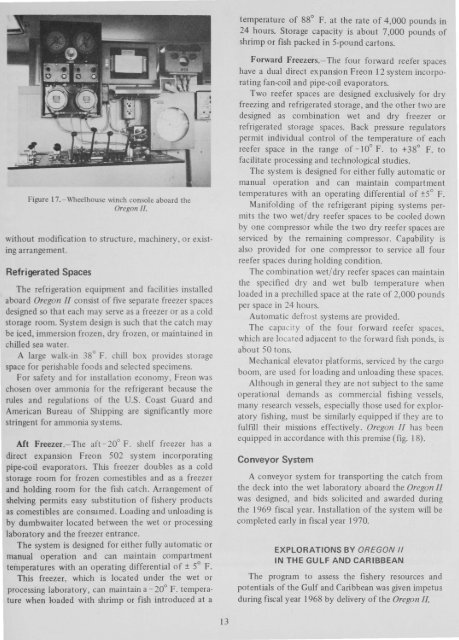Bureau of Commercial Fisheries - NMFS Scientific Publications Office
Bureau of Commercial Fisheries - NMFS Scientific Publications Office
Bureau of Commercial Fisheries - NMFS Scientific Publications Office
You also want an ePaper? Increase the reach of your titles
YUMPU automatically turns print PDFs into web optimized ePapers that Google loves.
Figure 17. - Wheelhouse winch console aboard the<br />
Oregon II.<br />
without modification to structure, machinery, or existing<br />
arrangement.<br />
Refrigerated Spaces<br />
The refrigeration equipment and facilities installed<br />
aboard Oregon II consist <strong>of</strong> five separate freezer spaces<br />
designed so that each may serve as a freezer or as a cold<br />
storage room. System design is such that the catch may<br />
be iced, immersion frozen, dry frozen, or maintained in<br />
chilled sea water.<br />
A large walk-in 38° F. chill box provides storage<br />
space for perishable foods and selected specimens.<br />
For safety and for installation economy, Freon was<br />
chosen over ammonia for the refrigerant because the<br />
rules and regulations <strong>of</strong> the U.S. Coast Guard and<br />
American <strong>Bureau</strong> <strong>of</strong> Shipping are significantly more<br />
stringent for ammonia systems.<br />
Aft Freezer.-The aft-20° F. shelf freezer has a<br />
direct expansion Freon 502 system incorporating<br />
pipe-coil evaporators. This freezer doubles as a cold<br />
storage room for frozen comestibles and as a freezer<br />
and holding room for the fish catch. Arrangement <strong>of</strong><br />
shelving permits easy substitution <strong>of</strong> fishery products<br />
as comestibles are consumed. Loading and unloading is<br />
by dumbwaiter located between the wet or processing<br />
laboratory and the freezer entrance.<br />
The system is designed for either fully automatic or<br />
manual operation and can maintain compartment<br />
temperatures with an operating differential <strong>of</strong> ± 5° F.<br />
This freezer, which is located under the wet or<br />
processing laboratory, can maintain a-20° F. temperature<br />
when loaded with shrimp or fish introduced at a<br />
13<br />
temperature <strong>of</strong> 88° F. at the rate <strong>of</strong> 4,000 pounds in<br />
24 hours. Storage capacity is about 7,000 pounds <strong>of</strong><br />
shrimp or fish packed in 5-pound cartons.<br />
Forward Freezers.- The four forward reefer spaces<br />
have a dual direct expansion Freon 12 system incorporating<br />
fan-coil and pipe-coil evaporators.<br />
Two reefer spaces are designed exclusively for dry<br />
freezing and refrigerated storage, and the other two are<br />
designed as combination wet and dry freezer or<br />
refrigerated storage spaces. Back pressure regulators<br />
permit individual control <strong>of</strong> the temperature <strong>of</strong> each<br />
reefer space in the range <strong>of</strong> _10° F. to +38° F. to<br />
facilitate processing and technological studies.<br />
The system is designed for either fully automatic or<br />
manual operation and can maintain compartment<br />
temperatures with an operating differential <strong>of</strong> ±5° F.<br />
Manifolding <strong>of</strong> the refrigerant piping systems permits<br />
the two wet/dry reefer spaces to be cooled down<br />
by one compressor while the two dry reefer spaces are<br />
serviced by the remaining compressor. Capability is<br />
also provided for one compressor to service all four<br />
reefer spaces during holding condition.<br />
The combination wet/ dry reefer spaces can maintain<br />
the specified dry and wet bulb temperature when<br />
loaded in a prechilled space at the rate <strong>of</strong> 2,000 pounds<br />
per space in 24 hours.<br />
Automatic defrost systems are provided.<br />
The capacity <strong>of</strong> the four forward reefer spaces,<br />
which are located adjacent to the forward fish ponds, is<br />
about 50 tons.<br />
Mechanical elevator platforms, serviced by the cargo<br />
boom, are used for loading and unloading these spaces.<br />
Although in general they are not subject to the same<br />
operational demands as commercial fishing vessels,<br />
many research vessels, especially those used for exploratory<br />
fishing, must be similarly equipped if they are to<br />
fulfill their missions effectively. Oregon II has been<br />
equipped in accordance with this premise (fig. 18).<br />
Conveyor System<br />
A conveyor system for transporting the catch from<br />
the deck into the wet laboratory aboard the Oregon II<br />
was designed, and bids solicited and awarded during<br />
the 1969 fiscal year. Installation <strong>of</strong> the system will be<br />
completed early in fiscal year 1970.<br />
EXPLORATIONS BY OREGON /I<br />
IN THE GULF AND CARIBBEAN<br />
The program to assess the fishery resources and<br />
potentials <strong>of</strong> the Gulf and Caribbean was given impetus<br />
during fiscal year 1968 by delivery <strong>of</strong> the Oregon II.
















